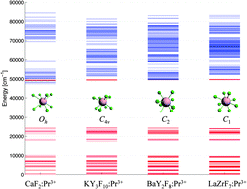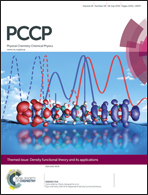Ligand field density functional theory for the prediction of future domestic lighting†
Abstract
We deal with the computational determination of the electronic structure and properties of lanthanide ions in complexes and extended structures having open-shell f and d configurations. Particularly, we present conceptual and methodological issues based on Density Functional Theory (DFT) enabling the reliable calculation and description of the f → d transitions in lanthanide doped phosphors. We consider here the optical properties of the Pr3+ ion embedded into various solid state fluoride host lattices, for the prospection and understanding of the so-called quantum cutting process, being important in the further quest of warm-white light source in light emitting diodes (LED). We use the conceptual formulation of the revisited ligand field (LF) theory, fully compatibilized with the quantum chemistry tools: LFDFT. We present methodological advances for the calculations of the Slater–Condon parameters, the ligand field interaction and the spin–orbit coupling constants, important in the non-empirical parameterization of the effective Hamiltonian adjusted from the ligand field theory. The model shows simple procedure using less sophisticated computational tools, which is intended to contribute to the design of modern phosphors and to help to complement the understanding of the 4fn → 4fn−15d1 transitions in any lanthanide system.

- This article is part of the themed collection: Density functional theory and its applications

 Please wait while we load your content...
Please wait while we load your content...